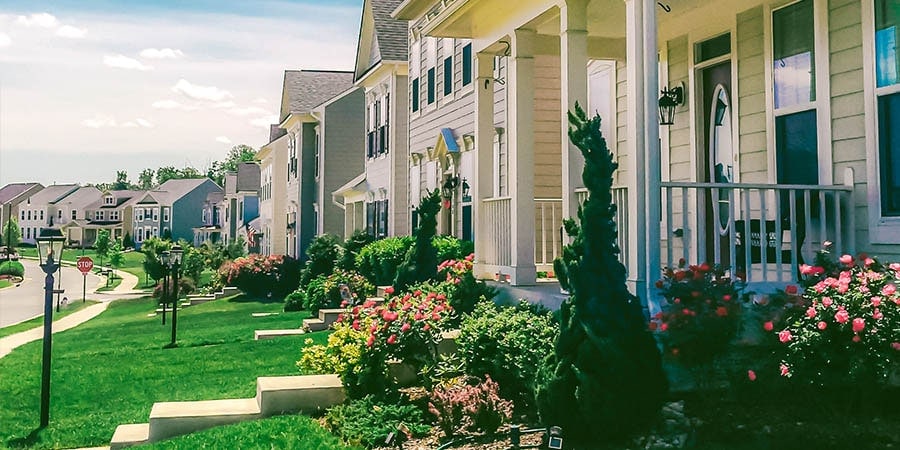Did you know that a burglary happens every 25 seconds? Or that the average burglar is under 24? Find out how to help protect your home.
According to the FBI, the burglary rate decreased in 2019. And while that's good news, data estimates that around 6,925,677 property crimes still happened in 2019 [1].
We'll go over some home burglary statistics and facts, then answer your most pressing questions, like how to prevent break-ins from happening in your home. But first off, do you know the difference between a burglary and a robbery?
What's the difference between burglary and robbery?
The FBI defines burglary as " the unlawful entry of a structure to commit a felony or theft. To classify an offense as a burglary, the use of force to gain entry need not have occurred. . . [There are] three subclassifications for burglary: forcible entry, unlawful entry where no force is used, and attempted forcible entry.” Structures include your house or apartment, as well as a barn, or another permanent residence, excluding cars. [1]
A robbery is "the taking or attempting to take anything of value from the care, custody, or control of a person or persons by force or threat of force or violence and/or by putting the victim in fear." Treated as a felony, it includes hefty fines and sometimes imprisonment.
Home burglary statistics and facts:
Burglaries happen worldwide, but that doesn’t mean you have to live in fear. We'll arm you with knowledge about home break-ins and give you some tips and ideas on how you can help protect your family today.
Every 4.4 seconds, a property crime occurs.
A home burglary happens once every 25.7 seconds
One robbery occurs every 1.9 minutes.
1.4 million homes were broken into in 2019 [3].
Property crimes—including burglaries and larceny-theft—resulted in $15.8 billion in losses in 2019 [1].
Burglaries account for $3 billion in property losses [1].
$2,661 is the average loss per offense [1].
Thieves look for cash more often than other items [5].
Valuables (i.e., jewelry and precious metals) are also highly sought-after [5].
Only about 28.9% of stolen property is recovered [1].
55.7% of break-ins involve forcible entry, 37.8% are unlawful entries into the home, and 6.5% of would-be burglars attempt forcible entry into a home. [1].
Residential properties account for over 60% of burglary offenses [1].
Urban areas experience the most property crimes, at 153 per 1000 people [3].
In the Northeast, burglaries decreased 13.5%. In the Midwest, that number was 10.3%. As for the West, the number lessened 9.4% and 8.4% in the South [1].
50% of burglars in one study, when confronted with a security system, would stop trying to break in, even though Nationwide found that only 34% of people own a security system [6].


The profile of an average burglar
What do you think of when you think about a typical burglar? Do you picture the masked bandit popularized on television or someone closer to home?
The modern burglar adapts to technology, circumstance, and opportunity, so it’s important to be watchful in your neighborhood.
Most burglars are males between 18-24 [2]. Many of them already have an arrest record. About half of them admit they engaged in a residential burglary the previous year [4].
50% of burglars live within two miles of the house they steal from [2].
41% admit that the crime is an opportunistic burglary [4].
Of those that plan the burglary, almost half do so within 24 hours [4].
The average thief takes less than 12 minutes to burglarize your home [2].
Screwdrivers, pliers, and hammers are standard tools [2].
25% of thieves gain access from the open front or back door [6].
As many as 75% of burglars confess they start in the master bedroom first, while 26% said they check out an office or study first.
62.3% use a vehicle during the break-in. About 1/8 use a stolen vehicle [1].
What else do burglars buy with money from stolen goods?
While 64% of burglars use the money they get on drugs, here’s a quick breakdown of other purchases made using cash from stolen items [4].


What are the chances your house will be robbed?
The good news is that the FBI’s statistics seem to point towards fewer burglaries, but that doesn’t mean you should let your guard down. If you know when a thief commonly breaks in, you can keep an eye on your home, especially during those times.
1. What time of day do most break-ins occur?
Many break-ins occur during the day when parents are at work and kids are in school. The most common times are between 10:00am-3:00pm, and specifically after lunch, 12:30-1:00pm.
Most burglaries occur during summer, decreasing almost 11% in winter, 9% less in spring, and 6% lower in fall than in the summer months. Robberies don’t statistically differ from season to season.
Average % difference in the seasonal rate of burglaries |
|
| Summer | Season with the most burglaries |
| Winter | -10.5% |
| Spring | -8.8% |
| Fall | -5.9% |
Do burglars case your home?
When a burglar cases your home, it means they are keeping an eye on it as a potential target. The thieves take note of your work and sleep schedule, so they can choose the perfect time to break in and take your possessions.
In data compiled from UNC Charlotte, about 12% of burglars admitted to planning the burglary [4].
When planning did happen, 49% of them burglarized a home within 24 hours, while 16% chose to commit the crime in 1-3 days [4].
25% of homeowners in an insurance study admitted that they left their doors unlocked at least once while away, and 35% admitted leaving a first-floor window unlatched [6].
When casing a home, some burglars even admit that they dress us as utility workers or pretend they are at the wrong house or looking for a lost dog.
What can I do to prevent a residential burglary?
Since many burglaries happen because of open windows and doors, it’s important to lock them—even when you’re home. Here are a few other tips and tricks you can do:
Leave a car in the driveway. It makes your home look occupied, even if it’s not.
Ensure garage doors, windows, sheds, and both front and back doors remain locked at all times.
A would-be thief often walks right through an unlocked door or window, so it’s essential to latch your windows, even if you’re home [6].
Install deadbolt locks on the front and back doors, as well as a garage door.
Upgrade sliding glass doors to safety glass. You can also purchase blocking bars, making it even harder for someone to break in.
Keep lawnmowers, grills, bicycles, and other large items out of the front yard.
Draw curtains and blinds in the lower-level and basement windows.
Install a security system to protect your valuables from a would-be burglar.
Don’t leave a spare key under your doormat, inside a pot, or above your door frame.
And a few more tips from a police department:
Install motion-sensing exterior lights.
Trim trees and shrubbery.
Confirm that door hinge installation is on the inside.
Create a Neighborhood Watch group to keep an eye on your neighborhood. (This also gives you the chance to get to know your neighbors better and fosters a sense of community.)
What are the top 10 states with the highest and lowest burglary rates?
Some neighborhoods are more susceptible to residential burglary. The highest state per 100,000 people in 2019 was New Mexico at 696.8 burglaries, while the lowest state was New Hampshire with 126.3.
If you check out your local county’s police blotter or police department website, you can get an idea of current crime in your neighborhood. A crime map is a great way to see a localized view of your neighborhood.
These states have the most burglary rates, per 100,000 people
New Mexico
Oklahoma
Mississippi
Arkansas
Louisiana
South Carolina
Alabama
North Carolina
Nevada
Alaska
These states have the lowest burglary rates, per 100,000 people
New Hampshire
New York
Virginia
Maine
Massachusetts
Connecticut
Pennsylvania
New Jersey
Vermont
Wisconsin
What are the top 10 cities with the highest and lowest burglary rates?
Lake Charles, Louisiana, has the highest rate of burglaries per 100,000 residents, at 1117.7. With Fairbanks, Alaska, on the lower end of the spectrum with 529.7 burglaries.
Highest burglary rates in USA cities per 100,000 people:
Lake Charles, LA
Alexandria, LA
Jonesboro, AR
Florence, SC
Monroe, LA
Bakersfield, CA
Vallejo, CA
Lubbock, TX
Lawton, OK
Danville, IL
Lowest burglary rates in USA cities per 100,000 people:
Fairbanks, AK
Victoria, TX
Columbia, SC
St. Joseph, MO/KS
Spokane/Spokane Valley, WA
Vineland-Bridgeton, NJ
Lima, OH
Baton Rouge, LA
Gulfport/Biloxi, MS
Lake Havasu City/Kingman, AZ


ADT is here to help.
From giving you a better understanding of why thieves target homes to offering safety tips to help keep you and your home safe, we hope that these home invasion statistics and facts have given you the tools you need to help protect your home.
Want to take your home’s security to the next level? Give us a call; ADT gives you protection you can trust from the leader in smart home security.
Frequently Asked Questions about Burglars
1. Do burglars mark homes?
Making a home is when a would-be thief places a mark or symbol (commonly in chalk, but also flyers) onto surfaces around your property—like the side of your garage, a mailbox post, garden shed, or even the home itself. Be on the lookout for these markings and remove them promptly if found.
2. What is the likelihood that your home will be burglarized?
The U.S. Department of Justice says that 0.82% of households experienced burglary in 2019 and that this number is the lowest it’s been since 1993. And while this is great news, over 1.4 million homes are still burglarized every year.
3. How long does the average home burglary take?
Most thieves want to snatch small valuables quickly and leave before being caught. The average burglary takes between 90 seconds-12 minutes, according to the FBI [2].
4. How do burglars break into homes?
Many home invasions happen because burglars walk through open doors or unlocked windows. But they also kick down doors or break windows, too.
5. What do burglars steal from your home?
Residential burglars most often go for cash, as well as electronics like phones and laptops, prescription drugs, jewelry, furs, and firearms.
[1] https://ucr.fbi.gov/crime-in-the-u.s/2019/crime-in-the-u.s.-2019/topic-pages/burglary
[2] http://www.jsu.edu/police/docs/Schoolsafety.pdf
[3] https://bjs.ojp.gov/content/pub/pdf/cv19.pdf
[5] https://s3.amazonaws.com/static.cammy.com/reports/burglar-survey-study-final-report.pdf
[5] https://crime-data-explorer.app.cloud.gov/pages/explorer/crime/property-crime
Related Articles:


